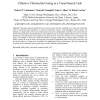Free Online Productivity Tools
i2Speak
i2Symbol
i2OCR
iTex2Img
iWeb2Print
iWeb2Shot
i2Type
iPdf2Split
iPdf2Merge
i2Bopomofo
i2Arabic
i2Style
i2Image
i2PDF
iLatex2Rtf
Sci2ools
INTERACT
2003
2003
Effective Vibrotactile Cueing in a Visual Search Task
: This paper presents results from work we have done into the combination of visual and vibrotactile cues for improving user interaction in virtual environments. Using a custom-designed control system, the intensity of a large number of low-cost vibrational devices can be independently controlled. Our current task is to determine the parameters and design-space for providing this type of cueing to support effective HCI. In a visual search task, user performance was compared over three levels of visual cues and four levels of vibrotactile cue types, in an attempt to narrow the visual search field for locating a letter from a random display of letters. Our results confirm the work of others, showing that users perform significantly faster when given visual cues, and that in the absence of visual cues, vibrotactile cues significantly improve performance. We also found that the waveform of the vibrotactile cue does not seem to make a difference in performance.
| Added | 31 Oct 2010 |
| Updated | 31 Oct 2010 |
| Type | Conference |
| Year | 2003 |
| Where | INTERACT |
| Authors | Robert W. Lindeman, Yasuyuki Yanagida, John L. Sibert, Robert A. Lavine |
Comments (0)

